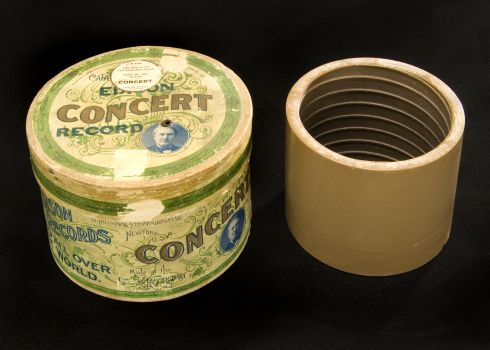Concert Cylinders of the Brown Wax Era

Concert cylinders were large diameter brown-wax records sold by Columbia, Edison and others beginning in late 1898. Columbia called them Graphophone Grand records, while Edison named them simply Concert Records. Concert cylinders were five inches in diameter—more than twice the size of standard cylinders—and could deliver a louder recording, suitable for public performance. Five-inch cylinders were first recorded at 120 rpm, then 144 rpm in late 1899, and finally 160 rpm in early 1902.
Early concert cylinder recordings also delivered better sound quality than standard cylinders, and the price of these concerts was correspondingly high—$4 to $5, compared with 35 to 50 cents for a standard cylinder. In addition, they were very large, took up a lot of space, and were infamously fragile. As a result, they did not sell well, and relatively few survive today. Nearly 173,000 Edison concert cylinders were sold in 1901-02 compared with nearly 2 million Edison two-minute wax cylinders.
Few early concert cylinders were original recordings. Most early concert cylinders were pantographic copies of molded five-inch master recordings. The pantographic process produced commercial copies with excellent audio response. Audio quality continued to improve when two-minute Gold Moulded cylinders began to be used as pantograph masters in 1901. Continued improvements in two-minute wax recordings were reflected in concert cylinders as the decade went on.
As concert sales continued, prices were halved and halved again, until by 1904 the cylinders were selling for 75 cents each.. Although standard cylinders were by then being made by a molding process using black wax, concert cylinders were never molded (except by Lambert Records, which manufactured an "indestructible" celluloid five-inch record).
Ever faithful to his customers, Edison produced Concert cylinders until late 1911. Edison discontinued producing wax entertainment cylinders altogether in January 1914.However, the Edison Co. manufactured brown wax blank cylinders for office dictation use well into the 1950s.
There are about hundreds of concert cylinder recordings on the cylinder site, but with electrical reproduction it is almost impossible to tell that a recording is a concert cylinder.

